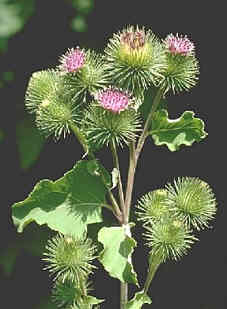
Plant Description
Caution & Interaction

Latin (botanical) name:
Arctium lappa
Common names: Lappa, Fox's Clote, Thorny Burr, Beggar's Buttons, Cockle Buttons, Love Leaves, Philanthropium, Personata, Happy Major, Clot-Bur
Plant Description: The Burdock plant is a member of the thistle family and can be found most often in the pastures of North America. In its preferred climate with sufficiently damp soil, it may exceed three feet in height. The Burdock plant produces burrs that are known to adhere to clothing and animal fur. The flower is purple and the leaves grow at alternating levels on both sides of the stem. The heart shaped leaves are green on top and whitish on the bottom. The roots, stems and seeds can be eaten. The leaves are often used in salads and the stems are boiled to be eaten like asparagus. The root of the Burdock is the essential part used in medicinal preparations. Its root contains exceptional levels of B complex and vitamin E, as well as trace minerals such as potassium, phosphorous, chromium, cobalt, iron, magnesium, silicon, zinc and sodium.
Medicinal Properties &Uses: Properties of Burdock Root are alterative, diuretic and diaphoretic. Considered to be one of the best blood purifiers, it is also used externally for the treatment of most skin ailments. It is very useful in the treatment of boils, scurvy and rheumatic affections because of anti-scorbutic properties in the root. Its mucilaginous and demulcent qualities have also made it highly recommended for external use in the treatment of ulcers and scaly skin disorders.
Dosage: 30-60 drops in water or juice, 2-3 times daily or as needed. Shake well before using.
Cautions & Interactions: Keep out of reach of children.
Efficacy Studies & Other Clinical Data:
Helpful Links:
Disclaimer (U.S. Only): These statements have not been evaluated by the FDA. These products are not intended to diagnose, cure, treat, or prevent any disease.
Common names: Lappa, Fox's Clote, Thorny Burr, Beggar's Buttons, Cockle Buttons, Love Leaves, Philanthropium, Personata, Happy Major, Clot-Bur
Plant Description: The Burdock plant is a member of the thistle family and can be found most often in the pastures of North America. In its preferred climate with sufficiently damp soil, it may exceed three feet in height. The Burdock plant produces burrs that are known to adhere to clothing and animal fur. The flower is purple and the leaves grow at alternating levels on both sides of the stem. The heart shaped leaves are green on top and whitish on the bottom. The roots, stems and seeds can be eaten. The leaves are often used in salads and the stems are boiled to be eaten like asparagus. The root of the Burdock is the essential part used in medicinal preparations. Its root contains exceptional levels of B complex and vitamin E, as well as trace minerals such as potassium, phosphorous, chromium, cobalt, iron, magnesium, silicon, zinc and sodium.
Medicinal Properties &Uses: Properties of Burdock Root are alterative, diuretic and diaphoretic. Considered to be one of the best blood purifiers, it is also used externally for the treatment of most skin ailments. It is very useful in the treatment of boils, scurvy and rheumatic affections because of anti-scorbutic properties in the root. Its mucilaginous and demulcent qualities have also made it highly recommended for external use in the treatment of ulcers and scaly skin disorders.
Dosage: 30-60 drops in water or juice, 2-3 times daily or as needed. Shake well before using.
Cautions & Interactions: Keep out of reach of children.
Efficacy Studies & Other Clinical Data:
Helpful Links:
Disclaimer (U.S. Only): These statements have not been evaluated by the FDA. These products are not intended to diagnose, cure, treat, or prevent any disease.